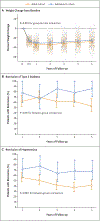Five-Year Outcomes of Gastric Bypass in Adolescents as Compared with Adults
- PMID: 31116917
- PMCID: PMC7345847
- DOI: 10.1056/NEJMoa1813909
Five-Year Outcomes of Gastric Bypass in Adolescents as Compared with Adults
Abstract
Background: Bariatric surgery results in weight loss and health improvements in adults and adolescents. However, whether outcomes differ according to the age of the patient at the time of surgery is unclear.
Methods: We evaluated the health effects of Roux-en-Y gastric bypass in a cohort of adolescents (161 patients enrolled from 2006 through 2012) and a cohort of adults (396 patients enrolled from 2006 through 2009). The two cohorts were participants in two related but independent studies. Linear mixed and Poisson mixed models were used to compare outcomes with regard to weight and coexisting conditions between the cohorts 5 years after surgery. The rates of death and subsequent abdominal operations and selected micronutrient levels (up to 2 years after surgery) were also compared between the cohorts.
Results: There was no significant difference in percent weight change between adolescents (-26%; 95% confidence interval [CI], -29 to -23) and adults (-29%; 95% CI, -31 to -27) 5 years after surgery (P = 0.08). After surgery, adolescents were significantly more likely than adults to have remission of type 2 diabetes (86% vs. 53%; risk ratio, 1.27; 95% CI, 1.03 to 1.57) and of hypertension (68% vs. 41%; risk ratio, 1.51; 95% CI, 1.21 to 1.88). Three adolescents (1.9%) and seven adults (1.8%) died in the 5 years after surgery. The rate of abdominal reoperations was significantly higher among adolescents than among adults (19 vs. 10 reoperations per 500 person-years, P = 0.003). More adolescents than adults had low ferritin levels (72 of 132 patients [48%] vs. 54 of 179 patients [29%], P = 0.004).
Conclusions: Adolescents and adults who underwent gastric bypass had marked weight loss that was similar in magnitude 5 years after surgery. Adolescents had remission of diabetes and hypertension more often than adults. (Funded by the National Institute of Diabetes and Digestive and Kidney Diseases; ClinicalTrials.gov number, NCT00474318.).
Copyright © 2019 Massachusetts Medical Society.
Figures


Comment in
-
In Teens with Severe Obesity, Can Bariatric Surgery Wait until Adulthood?N Engl J Med. 2019 May 30;380(22):2175-2177. doi: 10.1056/NEJMe1905778. Epub 2019 May 16. N Engl J Med. 2019. PMID: 31116946 No abstract available.
-
Metabolic and bariatric surgery in adolescents.Nat Rev Gastroenterol Hepatol. 2019 Oct;16(10):585-587. doi: 10.1038/s41575-019-0187-x. Nat Rev Gastroenterol Hepatol. 2019. PMID: 31308496 No abstract available.
-
Five-Year Outcomes of Gastric Bypass in Adolescents as Compared with Adults.N Engl J Med. 2019 Aug 29;381(9):e17. doi: 10.1056/NEJMc1908751. N Engl J Med. 2019. PMID: 31461607 No abstract available.
-
Five-Year Outcomes of Gastric Bypass in Adolescents as Compared with Adults.N Engl J Med. 2019 Aug 29;381(9):e17. doi: 10.1056/NEJMc1908751. N Engl J Med. 2019. PMID: 31461608 No abstract available.
-
Five-Year Outcomes of Gastric Bypass in Adolescents as Compared with Adults.N Engl J Med. 2019 Aug 29;381(9):e17. doi: 10.1056/NEJMc1908751. N Engl J Med. 2019. PMID: 31461609 No abstract available.
-
[Outcomes of bariatric surgery in adolescents as compared with adults : Teen-Longitudinal Assessment of Bariatric Surgery (Teen-LABS) vs. LABS].Internist (Berl). 2020 Mar;61(3):336-338. doi: 10.1007/s00108-020-00751-x. Internist (Berl). 2020. PMID: 32020262 German. No abstract available.
References
-
- Twig G, Tirosh A, Leiba A, et al. BMI at age 17 years and diabetes mortality in midlife: a nationwide cohort of 2.3 million adolescents. Diabetes Care 2016;39: 1996–2003. - PubMed
-
- Twig G, Yaniv G, Levine H, et al. Body-mass index in 2.3 million adolescents and cardiovascular death in adulthood. N Engl J Med 2016;374:2430–40. - PubMed
Publication types
MeSH terms
Substances
Associated data
Grants and funding
LinkOut - more resources
Full Text Sources
Other Literature Sources
Medical
Research Materials
